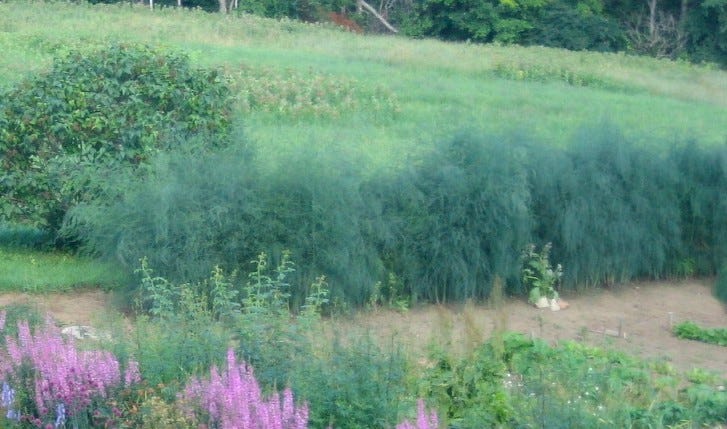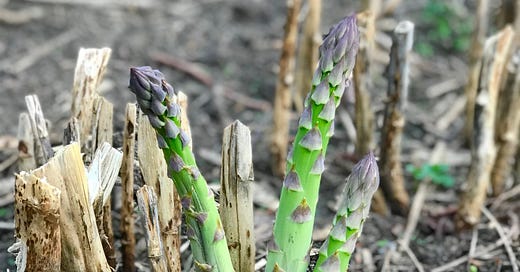JUST-CUT GREEN ASPARAGUS TASTES astringent, faintly bitter, green, fresh, delicate, sweet, tender — if you peel before you cook. Last week when we cut and immediately boiled some of our own, our visiting son said, “It’s a different vegetable.” He lives in an apartment in a small city, and if he eats asparagus, who knows when it was cut? Food writers don’t say so, but old asparagus tastes dirty, unfocused, earthy, crude, and animal. That’s why so much of it ends up grilled. Grilling distracts from the old taste, but it overwhelms the fresh one. The problem is that fresh asparagus is not easy to find unless you grow it yourself.
In the garden of the house where we used to live, I dug a trench about three feet wide, two feet deep, and more than 25 feet long. A friend who farmed close by used to deliver as much manure as I wanted. I filled the trench with a huge amount of it plus extra topsoil. (I filled in the last ten inches gradually, over a few weeks, after planting the crowns, as you’re supposed to do.) The plants grew powerfully robust. We ate asparagus every day during the season, we gave it away, and still we couldn’t keep up. Before the season was over, some of the fat spears left behind had opened into ferns. That’s the asparagus our children remember, and it gave me my understanding of freshness. By midsummer, the plants formed a hedge over six feet tall. People commonly asked what it was, because they’d never seen asparagus so tall and so dense that you couldn’t see through it.

I like to eat a spear in the garden, and raw strips are good in salad, but cooking makes asparagus really delicious. Peeling makes it even better — more delicate, sweeter. The difference is obvious in old asparagus because the old flavor is concentrated in the skin, but it’s clear too in the just-cut. At least once each season I don’t bother to peel and I regret it. Besides making the taste more elegant (that may be the best word), peeling eliminates the stringiness and any dirt that the rain has splashed behind the bracts on the stems. Peeling also allows the spears to cook more evenly: the tips cook first, and if you don’t act in time they fall apart.
Green asparagus to me is more interesting than white, although a fat, meaty, luxurious white spear is wonderful. You have to peel white asparagus because it’s inherently stringier. It also loses freshness faster, getting a cardboard flavor; growers chill it in the field. Green asparagus isn’t quite as vulnerable, but it would benefit from the same treatment. (Peru supplies the United States with white asparagus, not for any reason of soil or climate but thanks to a trade agreement whose aim in part was to encourage farmers to grow other crops in place of coca. At the moment, however, Peruvian asparagus is subject to a 10 percent baseline tariff, assuming the courts allow it.) Purple asparagus is a sweeter, milder, tenderer variation on the green, creamier in flavor and texture, but not better.
Most US and Canadian asparagus comes from Mexico. Few large growers are left in California, and small-scale North American growers don’t often raise asparagus because of the labor. You have to harvest every day, each spear has to be cut by hand, and the harvest takes place in spring when there’s plenty of other work to do. On warm, sunny days, the spears push up fast.
For flavor, the best American variety may be the open-pollinated Mary Washington. The Jersey hybrids that set the standard for high yield ceased to be produced in 2021. The current leading hybrid is Millennium (from the University of Guelph in Ontario), which has still more of the advantages of the Jersey kinds, including being higher in yield. That’s because it has a higher proportion of male plants. Females put some of their energy into producing seed (inside the red berries), so their spears are somewhat smaller, and the seeds fall to the ground, where they sprout and produce small competing plants. Nonetheless, for flavor, I grow the mixed-gender Mary Washington, a USDA variety from 1919.
If, in a garden, you see some spears that aren’t arrow straight but have wobbly curves or are even bent over, that’s because of asparagus beetles. Both the larvae and the adults feed on the plants. The common asparagus beetle is black with six white spots, and the spotted asparagus beetle is red-orange with twelve black spots. The organic solution is to pick them by hand and drop them into soapy water. The common kind lays minute dark eggs that stick out on end from the spears, while the eggs of the spotted are more greenish and adhere on their sides. Spears with eggs are off-putting and considered unsaleable, although the eggs rub off.
You pick the spears for six to eight weeks until the remaining ones are pencil thin. Then you let the plants grow and build strength for next year. In a store or at a stand, look for tight tops, an alive appearance (definitely not dry), a minimum of white bottom stem, and recent bottom cuts (suggesting a recent harvest, although the stems may have been recut). Buy from a refrigerated case or go early to a farmer’s market.
The stalks conveniently break at the point where they become tender. If, instead, you slice off the tail ends with a knife, you inevitably take some edible stalk or leave some fibrous toughness, which no amount of peeling will cure. Especially with bought asparagus, there’s waste. I should say that peeling pencil-thin spears isn’t practical.
The best asparagus preparations maximize freshness. There’s asparagus soup (this one has just three ingredients apart from salt and pepper), asparagus with sauce maltaise (hollandaise with fresh blood-orange juice — the seasons slightly overlap), and asparagus in scrambled eggs (even better if you include morels).
For adding to scrambled eggs or risotto, slice the asparagus 5-mm (¼-in) or thinner, and cook it gently in butter. Otherwise, boil it. It makes sense for a restaurant to tie up serving-sized bundles for boiling, although the center spears take a little longer to cook. I boil mine loose and pick them out in rough order of size, giving more time to the fattest. Just-picked asparagus is easy to overcook; it’s done in only two to five minutes, depending on the diameter. There’s no difference in taste between the thin and thick spears, but the thick are more fun to eat. For serving cold, some cooks “stop the cooking” by chilling the spears immediately in ice water. I’ve compared, and the water only washes away flavor.
The prime complement to asparagus is butter, then olive oil (alone or with a squeeze of lemon or a very little vinegar). If you move to sauce, the great complement is sauce maltaise, followed by béarnaise (hollandaise with tarragon), and regular hollandaise. Asparagus goes well with so many foods; some of the best combinations are with scallops, shad, softshell crabs, fish in general, dry-cured ham, guanciale (or bacon or salt pork), morels, boletes, and, on salad, sieved hard-cooked egg with finely chopped shallots.
Asparagus makes a wonderful course in itself, and then it certainly doesn’t need wine — French sommeliers didn’t use to serve wine with asparagus on the theory that no combination worked — but at one point I became fascinated. My book 50 Foods contains four fanatical, discouragingly specific paragraphs about interactions. It was a good analysis, still the best that I’m aware of, and I recommend it to the right person. But I must have put off all but a tiny handful of readers because hardly any bottle is a sure match unless (big catch) you know it works because you already tried it. The mini summary is: the wine must be white and just slightly sweeter than the asparagus, and if it has a floral aroma that’s all to the good. The bottles are out there, but no label indicates sweetness precisely enough to help. Pure Sauvignon, which is by far the most frequent recommendation, is never right. (Why it’s relentlessly recommended is a large question.) The great reliable success, not modest in price, is young Condrieu from the northern Rhone Valley, if it comes from a top producer. Try it with just-cut, boiled, buttered asparagus and you’re a world away from grilled asparagus. ●






I remember at the Friday and Saturday market in Piedmont, getting foraged wild asparagus that was wildly thin. They remain my favorite, but I rarely hear of anyone in the US foraging for it. Thanks for this primer!
Actually, a young, fresh (11,5% ABV) Grüner Veltliner and/or dry German Silvaner are lovely with asparagus.